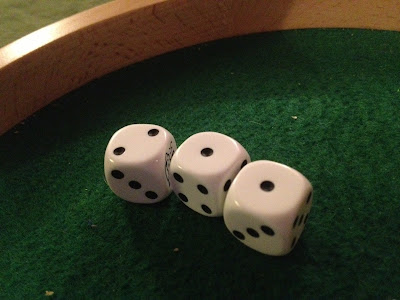
Today I will continue on what I was talking yesterday. In the rose petaled road with a small but vicious smiling dog, I approach character stats (or abilities, or attributes, depending on what book you are reading). They are the first things that start to give shape to a character. After the first idea or concept you may have, it is only after knowing their stats that you will truly have a grasp of how that character will be. Many times, depending on what numbers you get, you will end up changing your character concept.
It’s an interesting way of dealing with character creation, very different from the contemporary trend of planning your character in its minimal details. The random aspect of rolling stats actually brings uncertainty and adaptability to the table, that moment where nor even the player is sure of what they will play.
However, there are a few things to be noted about this design which are a bit problematic. In OD&D, going back to white box and similar versions, you will have a very low impact of stats into your character sheet. Bonuses go to +1 or -1, +10% to -20% xp. What this means is that stats serve more as a tool for roleplaying instead of actual mechanical improvement to your character’s rolls. Rolling low numbers is of little effect. When you get to other editions (B/X, BECMI, AD&D and similar versions and systems), you will see bonuses ranging from -3 to +3 (or more, if using AD&D tables). Mechanically, it’s triple the effect compared to OD&D. Rolling low on your stats is not only easier to give you problems, but also these problems will be harsher.
In practice, the bigger the effect of stats in the mechanics of the game, the harder it is to have them to be completely random in nature. Then, how to correct this without dismissing the random roll?
What I propose in the rose petaled road is a new rolling method and the usage of main stats and trading stat points:
Balancing roll Method: roll 3d6, 3 times. Each roll will give two results – the sum of the three dice, and the opposite, which is the value necessary to total 21. So, if you roll 12, then you choose one stat that will be 12, and other that will be 09. If you roll 3, one stat is 3 and the other is 18. If you roll 5, one is 5 and another is 16. Do so until all 6 stats are determined.
Trading points: Every class has main stats, a primary and secondary. If the book you use does not show them, use this (Primary, Secondary/Secondary):
-
Warriors and fighting-people – STR, DEX/CON
-
Clerics and divine-users – WIS, STR/CHA
-
Mages and magic-users – INT, WIS/CON
-
Thieves and rogue-scoundrels, DEX, INT/WIS
-
Bards and profession-artisans – CHA, DEX/INT
-
Barbarians and savage-striders - CON, STR/WIS
-
And the other-folks, Halflings (DEX, CHA/WIS), Elves (INT, DEX/WIS) and Dwarves (CON, STR/INT).
You may trade points of stats to improve your class's main stats. For each point you deduce one stat, you may improve your primary stat in one. For a secondary stat, every two points reduced improve in one. No stat can be improved beyond 16 or reduced below 5. Such values can only be attained through rolling.
This way, you will have a random array of stats for your character, but you will at least have some control over their main stats.
Next time, I will talk about the short story adventure in Petaled Road.

No comments:
Post a Comment